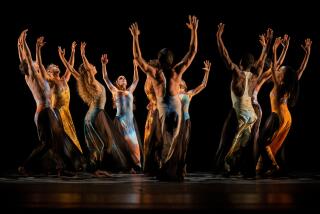Dance Review : Hayastan Ensemble Spins a Folk Mosaic Spectacle
The Hayastan Dance Ensemble, which made its professional debut at Ambassador Auditorium this weekend, is a theatricalized folk dance group in the mold of Russiaâs Moiseyev troupe. In fact, Hayastanâs founder in 1988 was the late Iosif Izrailov, who trained under Moiseyev before starting his own company here.
Sunday afternoon, about 40 dancers and musicians of mainly Armenian descent hit the hallmarks of Eastern European folk mosaic spectacle, often excelling at exciting athletic maneuvers in Georgian or Russian dances and delicate wreathing ballets of hands and arms in Armenian dances.
As usual, the province of the women was slow grace and decorous parading or flirting, while martial, virtuosic moves belonged to men. Although folk ensembles like this one have moved with the times enough to incorporate gold lame, ballet steps and modern choreographic strategies, the strictly conventional gender roles never budge.
Gravity, on the other hand, was dealt a blow each time guest performers Temur Koridze and Badri Esatia flew onstage with split jumps, bounding turns and Georgian âtoe dancing.â Other male soloists joined in the tasks of shooting the legs up in many directions from a crouched position and crossing the stage in impressive knee-to-floor swaggers.
Musicians onstage provided excellent accompaniment and solos, but tape was used for the overwrought, under-thought-out âThe Gypsies.â Demonstrating a primary danger in reducing ethnic groups to danced essences, women shimmied, and men raged--simplistically and insultingly.
In so-called traditional dancing, traditions are chosen for perpetuation every step of the way. Hayastan may want to reconsider that one.
More to Read
The biggest entertainment stories
Get our big stories about Hollywood, film, television, music, arts, culture and more right in your inbox as soon as they publish.
You may occasionally receive promotional content from the Los Angeles Times.










